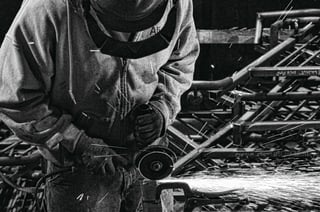How Tool Power Affects Abrasive Performance

By Elliot Shepherd, Associate Product Manager, Weiler Abrasives
Matching a tool with the right abrasive is of utmost importance in any application. Using the wrong product at the wrong speeds can hinder productivity and be dangerous for the operator and those working nearby.
When choosing a cutting or grinding wheel or flap disc, an operator needs to choose one that is rated equal to or higher than the free speed of the tool they are using. Larger wheels will need to be used with lower-RPM tools, while smaller ones can be used on much higher-RPM tools.
Over-speeding an abrasive can create a significant safety hazard. Keeping the tool guard on at all times is helpful to not only protect the operator but also to prevent using larger wheels or flaps discs on a tool that is not rated for them.
Additionally, operators need to make sure the arbor size hole on the wheels matches their mandrill very specifically. If they don’t match them correctly, the product could spin out-of-round, which can create another safety issue. A flap disc could also shatter or throw off the flaps, which also creates a generally unsafe environment.
Ultimately, operators should always read the product packaging and the operator’s manual for their tool and their abrasives and follow manufacturer recommendations when choosing an abrasive for their tool.
The Main Tools for the Job
A common tool for cutting, grinding or surface finishing is an electric right-angle grinder. This is used with cutting wheels, flap discs, and bigger grinding wheels.
Pneumatic die grinders, which are air-powered, are very good for small diameter work. An operator would use small diameter cutting wheels or flap discs on a die grinder.
An inline grinder is used to get into a tighter space or when the setup can’t accommodate the footprint of a right-angle or die grinder. On an inline grinder, the wheel is coming straight off the tool, unlike a right-angle grinder where it is turned to a right angle from the tool itself.
Factors That Affect Tool Power
There are several factors that affect tool power, and these should be considered to gain the best performance from an abrasive, as well as to keep it in safe operation.
Amperage:
A tool’s amperage keeps the motor spinning at the same speed consistently. If a tool has low amps and an operator puts pressure down on the abrasive, the tool will not be able to sustain a high RPM.
With higher-amperage tools, operators are able to keep that power and not produce so much heat in the motor, therefore helping the tool last longer and substantially increasing the efficiency of the abrasive.
Hardness of material:
The hardness of the abrasive also affects tool power. For example, an operator would need a higher-amperage tool to be able to maximize the efficiency of the grains on a ceramic cutting or grinding wheel. The wheel would need to spin at higher RPMs to be able to fracture the ceramic grains so they can self-sharpen and continue to provide top performance.
If an operator is using a low-amperage tool and is not getting the job done with a ceramic wheel, replacing it with a zirconia alumina (zirc) or an alumina oxide wheel — where it isn’t necessary to have the higher amount of power to fracture the grain — is an option. In many cases, it makes more sense, economically, to replace the abrasive rather than upgrade the tool.
Cutting or grinding angle:
An increased angle is going to give an operator more material removal when cutting or grinding, but it also can cause the operator to put more pressure onto the abrasive itself. More pressure adds more heat and the possibility of the tool bogging down unless it’s rated at a high amperage.
Extension cord quality:
If an operator is using an inexpensive or low-quality extension cord, it will affect tool power. Using a heavier-duty, thicker extension cord provides a very different type of power transfer for electric tools and allows for grinding with full RPMs for a longer period of time.
A thinner extension cord may allow the operator’s tool to run at free speed and at the RPM it is rated to, but it will likely bog down or stall out once the operator adds any kind of load to it.
Air compressor quality:
An operator has to consider what their air compressor is rated for compared to how many export air hoses are needed when using a pneumatic die grinder. If there are a hundred cells using air tools, multiple air compressors may be required to feed those cells to ensure they are not bogging down on their air pressure for the tools. The cell that is farthest away from the air compressor will have the least air pressure.
Abrasive Performance is Affected by Tool Power
Ceramic, zirc and alumina oxide cutting and grinding wheels do the same job but have varying lifespans. Ceramic is the highest quality and, generally, it lasts the longest. Zirc wheels wear out faster than ceramic and alumina oxide wear out a little quicker than zirc.
As mentioned earlier, ceramic wheels work better on a higher-amperage tool, while a zirc or alumina oxide product is generally better on lower-amperage tools. An operator can use a high-amperage tool with a zirc or an alumina oxide wheel, but it may not provide the same amount of life as with a ceramic wheel.
Using a higher load speed and a higher RPM means the wheel is spinning more and touching the material more, which leads to a noticeably shorter life compared to a lower-amperage tool. It creates more friction because of the pressure the operator is putting on it.
With lower-amperage tools, it can be perceived that the wheel is not doing its job, so the operator may feel the need to press harder, causing even more friction and heat, which is the enemy of an abrasive. As long as the operator knows a lower-amperage tool is in use, it is possible to use less pressure and get a longer life out of their alumina oxide or zirc product.
If a tool is spinning a disc at high RPMs, an operator may see pre-shed of grain because the grain isn’t made to hold on to the cloth or the wheel as hard or for as long as it normally would under the appropriate RPMs.
When spinning at too low of an RPM, the wheels can actually glaze over and round off. This will decrease the cut rate. The only way to get rid of glazing is to add more pressure, but once a wheel glazes, it’s hard to come back from that. An operator will have to get the glazing to break free to reveal a new fresh grain underneath or fracture the grain that’s already there.
Signs of Running at the Wrong Speed
A tool is not running at the right speed if it starts to bog down when the operator applies pressure. This could be because the motor in the tool is starting to fail. For pneumatic tools, it could be because the seals are starting to open up and that it’s time to rebuild the tool.
If an operator is running a disc too fast or applying too much pressure with a flap disc, for example, the glue that’s holding the flaps on the disc may begin to give off an odor. The operator will either want to ease up on the pressure or double check the tool-to-consumable RPM ratio to make sure they are rated for each other.
Check the Rating of the Tool and Abrasive
When choosing the right tool and abrasive for the job, it’s important for operators to check the product packaging and operator’s manual to make sure their product is rated equal to or above the RPM of the tool they are using. This will help maximize efficiency and productivity and help ensure a safer workplace. When in doubt about product or tool selection, consult a trusted distributor or abrasives manufacturer for help.
